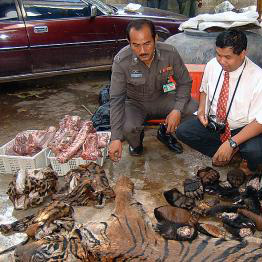 Some Pagans use animal parts in ritual. While this may seem a bit unsavory to some folks, it's really not that uncommon. A good guideline to follow is as follows:
Some Pagans use animal parts in ritual. While this may seem a bit unsavory to some folks, it's really not that uncommon. A good guideline to follow is as follows:
* if your tradition doesn't forbid the use of animal parts, AND
* the parts are gathered humanely and ethically
then there's no reason you can't use them. Let's look at some of the different parts you might want to use.
Thousands of years ago, our ancestors performed rituals and ceremonies. They didn’t have tools ordered from an online catalog or purchased at the Local Wytchy Shoppe. They made do with what they had. For the ancients, many of their tools -- both magical and mundane -- came from the animal kingdom. Few things went to waste. Bones could be turned into anything from a knife to a sewing needle. An antler could be used as a weapon or a farming tool. A horse's bladder might become a pouch to carry herbs. Anything was usable.
In some shamanic traditions, animal parts can be used to connect the practitioner to the animal. One might wear a necklace made of bear claws, a headdress of antlers, or use a fetish of bone and feathers. Some traditions still use these today. Someone wishing to celebrate fertility might use the antlers of a stag, for example. An individual hoping for transformation could perhaps powder a bit of snakeskin for use in a spell. A person who wants to develop their inspiration and creativity might use feathers in a working, and so forth.
Naturally Dropped Items
These are the items that animals discard on their own as part of the natural cycle. Snakes shed their skin regularly. Deer shed antlers after the fall mating season has ended, typically around January through April. A bird may lose feathers as it flies overhead. These are all items that drop on their own naturally, and there is nothing wrong with picking them up and using them.
Items from a Dead Animal
Animals die. It's part of the natural cycle of things. After they've died, sometimes you may find pieces of carcasses lying around. Bones, fur and other parts can be gathered from animal that has died on its own. If you happen to be a Pagan who hunts for food, you may wish to use some of the parts of the animal you've killed. This prevents waste, and allows you to maintain some connection with the animal after death. If you are the one who has made the kill, be sure you have done so in a humane and ethical manner. It's never okay to kill an animal just to use its parts in ritual.
Purifying Animal Parts
It's generally a good idea to offer some sort of thanks to the animal before using the item in ritual. As part of this process, you might want to cleanse or purify the object -- you can use smudging, asperging, or any other method of ritually purifying the item. You can also consecrate it as you would any other magical tool.
Suggested free e-books to read:
Benjamin Rowe - Comselha An Enochian Macrocosmic Ritual